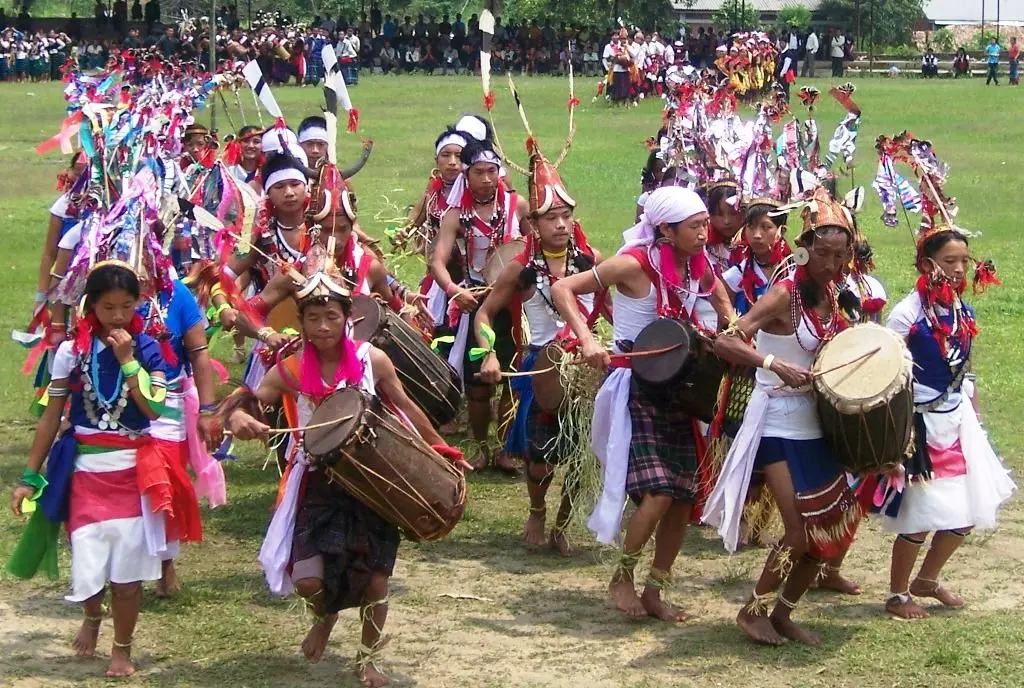Moh-Mol is basically agricultural related festival of Tangsas, which signifies end of an agricultural activity or beginning of crop season. Since life and activity of tribal people revolve around agriculture, they adhere to utmost important to this festival. It is a gala of pomp and show of traditional colourful costumes, ornaments, art and crafts that enriched the pride of Tangsa’s cultural heritage of the past. It therefore inspires younger generation every year to inherit, protect, preserve and continue it to the later generations further.
While some community of Tangsas observe it for beginning of agriculture activity in the field, some do it for sowing of paddy, and some other for welcoming new crop into home. That is why celebration is performed with religious fervor and devotion. People chant mantras for good harvest of their crops, prosperity of their live stocks and wealth, and disease free live of their family or village community to enjoy food and drinks year after year. So, the offerings, sacrifices, food, drinks, folk-songs and dances accompanied by rhythmic music of drum beats and gong reverberations highlight the festival.
As time of particular agriculture activity differ from village to village, time of their festival also vary accordingly. It is observed generally between April and July, but village community in the council as per their convenience decides exact date.
As Tangsas have no definite date to mark the New Year, the Moh-Mol festival is considered to be the end and beginning of the calendar. People of all ages, on this occasion, sing and dance with their best presentation in colorful attire. In a sense, they do it in order to shake off the shackles of old painful memories and fatigues, and to recharge their energy and enthusiasm, preparing to face reality of life in waiting.
This is also a wonderful occasion for people to exchange goodies, love and affection with their near and dear ones, especially, relatives who visit from distant villages or places. Bogged down by daily chores of their households, people usually look for “Moh/Mol” occasion to see those distant relatives.
“Moh/Mol” is also a forum for development of new friends and acquaintances. Many strangers come into contact on this day, and it may become a permanent relationship. Especially, it is common among young boys and girls who may knot their relation to grow into life time partner.
Some communities of Tangsa, on Moh-Mol eve or during, bid ritual farewell to departed soul of the family, if any member expired during the year. They believe deceased soul dwells in the family who needs farewell by offering foods and drinks for his/her peaceful rest in the ancestor realm.
Then there are prayer “ROM-ROM” to Godess of Crops “Tungaja Chamja” for blessing of bumper harvest, Godess of Prosperity for gain of wealth and “NONG” for longevity of the Nong Culture. All walks of people, irrespective of sex and age, lay down their hearts in enjoying food, drinks, songs, dances and music that filled the air of the ground with maddening effect.
However, with the passage of time, dedication, spirit and traditional costumes are seen continuously undergoing mark changes. The sensitive youths are, therefore, seriously concern over this fading and ever degenerating trend of traditional culture and colours of the society. They feel that it is high time for the society especially the youths to dedicate and mobilize resources for protection, preservation and propagation of tradition and culture for the future generations.
Pongtu Kuh festival: Pongtu Kuh is an oldest agricultural festival celebrated by Tutsas on the eve of rainy season. The literary meaning of Pongtu is “Pong” means wind, “Tu” means retreating, “khu” means festival. The festival is celebrated after the harvesting of millet to welcome the New Year and to drive the old. Pongtu is observed to offer prayer to the supreme god Rangkathok for bumper harvest and prosperity and seek security of the crops from occurrence of natural calamities and other destructions like pests etc. The agricultural based Pongtu is celebrated in the month of April every year with pomp and gaiety. The festival is marked by several events like practicing of Rom-Hom a traditional chicken sacrifice for producing fire through rubbing a bamboo stick in hay in order to forecast whether the year would prove prosperous for them or not. It is believed that the sacrifice is given to the deity of the house and is practiced by only a section of the Tutsa tribe. Colouful Tutsa dance displayed by folks of energetic and beautiful youths are the major attraction of the festival.
Shapawng Yang Manu Poi festival: Culturally rich Singpho festival, Shapawng Yang Manou Poi is celebrated in the month of February every year. The Singpho youths in their traditional wardrobe display colourful dances with their usual tradition of drinking and eating. The prayers are offered to the almighty for peace and prosperity of the people and area during the festival.
Source:(Changlang.nic.in)

